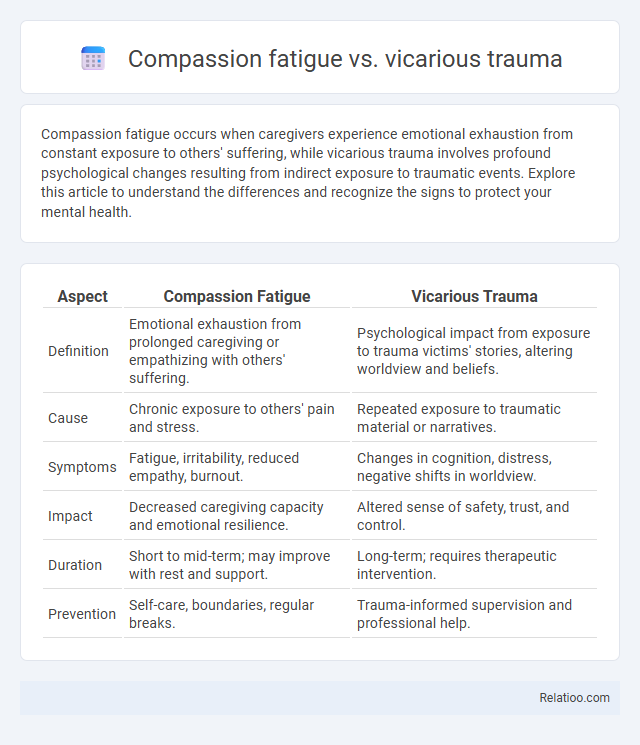Compassion fatigue occurs when caregivers experience emotional exhaustion from constant exposure to others' suffering, while vicarious trauma involves profound psychological changes resulting from indirect exposure to traumatic events. Explore this article to understand the differences and recognize the signs to protect your mental health.
Table of Comparison
| Aspect | Compassion Fatigue | Vicarious Trauma |
|---|---|---|
| Definition | Emotional exhaustion from prolonged caregiving or empathizing with others' suffering. | Psychological impact from exposure to trauma victims' stories, altering worldview and beliefs. |
| Cause | Chronic exposure to others' pain and stress. | Repeated exposure to traumatic material or narratives. |
| Symptoms | Fatigue, irritability, reduced empathy, burnout. | Changes in cognition, distress, negative shifts in worldview. |
| Impact | Decreased caregiving capacity and emotional resilience. | Altered sense of safety, trust, and control. |
| Duration | Short to mid-term; may improve with rest and support. | Long-term; requires therapeutic intervention. |
| Prevention | Self-care, boundaries, regular breaks. | Trauma-informed supervision and professional help. |
Understanding Compassion Fatigue
Compassion fatigue occurs when Your emotional resources are depleted from continuously caring for others, leading to physical and mental exhaustion. It differs from vicarious trauma, which involves deep psychological changes due to indirect exposure to traumatic events, and secondary traumatic stress, which is an immediate emotional reaction to others' trauma. Understanding compassion fatigue helps in recognizing symptoms early, such as emotional numbness, irritability, and reduced empathy, enabling effective self-care strategies to restore well-being.
Defining Vicarious Trauma
Vicarious trauma refers to the deep emotional residue or lasting psychological effect experienced by professionals exposed to others' traumatic stories, altering their worldview and sense of safety. Unlike compassion fatigue, which is characterized by physical and emotional exhaustion from constant caregiving, vicarious trauma fundamentally changes your cognition and beliefs due to cumulative traumatic exposure. Understanding the distinctions between vicarious trauma, compassion fatigue, and burnout is essential to implement effective self-care and therapeutic strategies.
Key Differences Between Compassion Fatigue and Vicarious Trauma
Compassion fatigue is the emotional exhaustion resulting from prolonged exposure to others' suffering, leading to decreased empathy and burnout, while vicarious trauma refers to the deep psychological impact that alters a caregiver's worldview due to indirect exposure to trauma. You may notice compassion fatigue affects your energy and motivation levels, whereas vicarious trauma reshapes core beliefs and can cause intrusive thoughts or symptoms similar to post-traumatic stress disorder. Understanding these key differences is crucial for implementing effective coping strategies and maintaining mental health in helping professions.
Common Symptoms and Warning Signs
Compassion fatigue, vicarious trauma, and burnout all share common symptoms such as emotional exhaustion, reduced empathy, and increased irritability, but compassion fatigue often presents with feelings of helplessness and decreased satisfaction in caregiving roles. Vicarious trauma primarily manifests through intrusive thoughts, negative changes in worldview, and heightened anxiety stemming from indirect exposure to clients' traumatic experiences. Warning signs across these conditions include withdrawal from social interactions, persistent fatigue, difficulty concentrating, and a notable decline in professional performance.
Causes and Risk Factors
Compassion fatigue arises primarily from prolonged exposure to patients' suffering, high emotional demands, and inadequate self-care, while vicarious trauma results from empathetic engagement with others' traumatic experiences, altering a caregiver's worldview and emotional well-being. Risk factors for compassion fatigue include repeated caregiving without respite, high caseloads, and personal trauma history, whereas vicarious trauma risk intensifies with direct exposure to clients' trauma narratives and lack of supportive supervision. Both conditions are prevalent among healthcare professionals, social workers, and first responders, highlighting the critical need for organizational support and resilience training.
Impact on Mental Health and Wellbeing
Compassion fatigue manifests as emotional exhaustion and reduced empathy due to prolonged exposure to others' suffering, severely impacting mental health by increasing anxiety, depression, and burnout. Vicarious trauma involves profound psychological changes from indirect exposure to traumatic events, leading to symptoms similar to PTSD, such as intrusive thoughts and hypervigilance, which significantly disrupt wellbeing. While both conditions affect caregivers and professionals in helping roles, compassion fatigue centers on emotional depletion, whereas vicarious trauma alters cognitive schemas and personal worldview, each requiring targeted interventions for mental health recovery.
Professions Most at Risk
Healthcare workers, first responders, therapists, and social workers face the highest risk of compassion fatigue due to constant exposure to patient suffering and emotional distress. Vicarious trauma predominantly affects professionals such as counselors, psychologists, and humanitarian aid workers who repeatedly engage with traumatic stories and experiences of clients. Understanding the differences in these conditions helps organizations develop targeted support systems for these high-risk professions to maintain mental well-being and job effectiveness.
Prevention and Coping Strategies
Preventing compassion fatigue and vicarious trauma involves establishing strong professional boundaries, engaging in regular self-care practices such as mindfulness and physical exercise, and seeking peer support or supervision. Coping strategies include practicing emotional regulation techniques, attending therapy or counseling, and maintaining a balanced workload to reduce exposure to secondary traumatic stressors. Early recognition of symptoms like emotional exhaustion and decreased empathy enables timely intervention and resilience-building measures.
Organizational Support and Resources
Organizational support plays a critical role in mitigating compassion fatigue, vicarious trauma, and burnout by providing access to mental health resources, regular training, and peer support groups designed to strengthen resilience among employees. Effective workplace policies include offering employee assistance programs (EAPs), promoting workload management, and facilitating open communication channels to address stressors and emotional challenges. Investing in comprehensive support systems results in improved staff well-being, reduced turnover rates, and enhanced capacity for sustained compassionate care.
When to Seek Professional Help
Recognizing when to seek professional help for compassion fatigue, vicarious trauma, or secondary traumatic stress is crucial for mental health and well-being. Persistent symptoms such as emotional exhaustion, intrusive thoughts, reduced empathy, or decreased job performance indicate the need for intervention by licensed mental health professionals specializing in trauma or caregiver support. Early consultation with therapists skilled in trauma-informed care can prevent progression and promote recovery, enhancing resilience among healthcare workers, first responders, and caregivers.

Infographic: Compassion fatigue vs vicarious trauma
 relatioo.com
relatioo.com